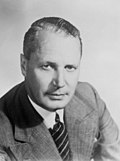Background
Because of the outbreak of war, the Legislative Assembly had passed Acts in 1942 [2] and 1943 [3] to defer the calling of a general election. The latter extension had received royal assent in April 1943, but Premier Harry Nixon came into office the following month and opted to call an earlier election on June 30, 1943, for August 4, 1943. Noting that the last extension had been vigorously opposed by the Progressive Conservative opposition, he said, "We know of no precedent in the British Empire where a parliament extended its own life against an opposition vote." [4]
Outcome
The Ontario Progressive Conservative Party, led by George Drew, defeated the Ontario Liberal Party government. The Liberal government had disintegrated over the previous two years because of a conflict between Mitchell Hepburn, the Ontario caucus and the federal Liberal Party of Canada.
Hepburn resigned and was eventually succeeded by Harry Nixon in early 1943. The change in leadership was not enough to save the government. The election held later that year resulted in the Conservative Party, recently renamed the "Progressive Conservative Party", winning a minority government. This began forty-two uninterrupted years of government by the Tories who combined moderate progressive policies with pragmatism and caution.
The Liberals fell to third place behind a new force, the socialist Ontario Co-operative Commonwealth Federation (CCF), led by Ted Jolliffe, went from obscurity to form the Official Opposition, winning 32% of the vote and 34 seats in the legislature, just four short of Drew's Tories. The Liberals and their Liberal-Progressive allies fell from 66 seats to a mere 15.
Two members of the banned Communist Party of Ontario running as "Labour" candidates won seats in the Legislature for the first time in this election: A.A. MacLeod in the Toronto riding of Bellwoods, and J.B. Salsberg in the Toronto riding of St. Andrews. Several days following the election the Labor-Progressive Party was officially formed and Salsberg and MacLeod agreed to sit in the legislature as the party's representatives.
The Legislature's first two female MPPs were elected in 1943:
This page is based on this
Wikipedia article Text is available under the
CC BY-SA 4.0 license; additional terms may apply.
Images, videos and audio are available under their respective licenses.






